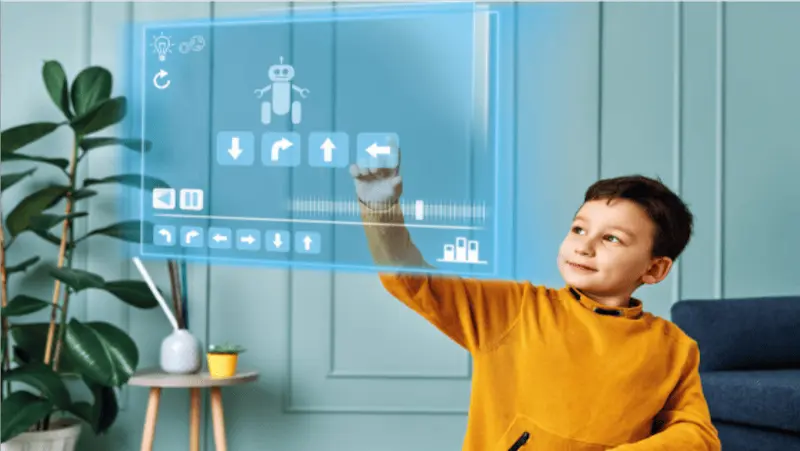Have you ever wondered how YouTube recommends your favorite videos? Or how a game learns to get harder the more you play?
That’s machine learning at work—and yes, kids can learn it too!
This guide is all about explaining machine learning for kids in a super simple way. No hard words. Just fun ideas and easy projects.
What Is Machine Learning?
Let’s say you’re teaching your dog to sit.
You give a treat every time it sits.
After a while, your dog learns what to do.
That’s kind of what machine learning is! But instead of dogs, you’re teaching computers using data and examples.
Breaking It Down: The 3-Step Idea
Here’s how machine learning works:
1. Learn from Data
Computers look at a lot of examples. Like photos of cats and dogs.
2. Find Patterns
They notice what makes a cat look different from a dog.
3. Make Decisions
When they see a new photo, they “guess” if it’s a cat or dog.
Infographic: How Kids Can Understand Machine Learning
That’s it! It’s like training your brain—just with computers.
So, Why Should Kids Learn It?
Because machine learning is already everywhere! For example:
- YouTube or Netflix suggests shows
- Voice assistants like Alexa or Siri answer your questions
- Games learn how good you are and change the challenge
If kids understand how these things work, they can build fun and smart tech too.
Cool Projects for Kids
Let’s look at a few easy ways to explore machine learning.
1. Teachable Machine (by Google)
This is a free tool online.
Kids can train a computer to:
- Recognize faces
- Identify objects
- Respond to hand signals
You just take pictures and let the machine “learn.” It’s that easy!
Try it at: teachablemachine.withgoogle.com
2. Cat or Dog Classifier
Want to build your own animal detector?
Use Scratch or Python (with adult help) to:
- Show pictures of cats and dogs
- Let the computer guess which is which
- See how good it gets over time!
Kids learn how machines guess—and sometimes make mistakes. That’s important too.
3. Smart Juice Bot
Let’s pretend you’re a robot taking drink orders.
You learn that people usually want cold juice in summer and hot drinks in winter.
You use that info to guess their order.
This is a fun paper or board game that teaches pattern guessing!
Tips for Parents and Teachers

- Start with stories: Explain ML using real-life examples.
- Use visuals: Draw or show how the computer “thinks.”
- Keep it fun: Mistakes are part of learning—just like with humans!
Kids don’t need to code to get the idea. They just need examples that relate to their world.
Example: How a Kid Helped a Robot
Ella, age 10, used a machine learning game to teach a bot to recognize her happy and sad faces.
At first, the robot got confused. But as she gave more pictures, it started guessing right.
“It’s like it became my friend,” she said.
That’s the magic of explaining machine learning for kids—it turns tech into play.
Where Kids Can Go Next
Once they get the basics, kids can:
- Build chatbots
- Design smart games
- Create cool filters like Snapchat
- Make their own YouTube thumbnail picker
The future is wide open—and learning early gives them a big head start.
Final Thoughts
Machine learning sounds tricky. But when you break it down, it’s just about helping computers learn from examples—like kids do!
With tools, games, and real-life examples, explaining machine learning for kids becomes fun, hands-on, and super exciting.
Who knows? Your child might just be the one to build the next smart robot!
FAQs: Explaining Machine Learning for Kids
1. What is machine learning in simple words?
Answer:
Machine learning is when a computer learns from examples instead of being told exactly what to do. It’s like when a kid sees lots of pictures of cats and dogs and then learns how to tell them apart.
2. Can kids really learn machine learning?
Answer:
Yes! With the right tools and examples, even young kids can understand the basics. They don’t need to know code—they just need to see how learning from data works.
3. Why is it important to teach machine learning to kids?
Answer:
Because machine learning is already everywhere! From video games to voice assistants, it’s part of daily life. Teaching kids early helps them understand the technology behind the things they use every day.
4. What are some fun ways to teach kids machine learning?
Answer:
There are fun tools like Google’s Teachable Machine, simple games, or even paper-based activities. Kids can train a computer to recognize objects, faces, or gestures—all through play.
5. Do kids need to know programming to learn ML?

Answer:
Not at all! Many beginner-friendly platforms use drag-and-drop systems or visuals. Kids can explore concepts before they even write a single line of code.
6. What age is best to start learning machine learning?
Answer:
Ages 8 and up is a great time to start introducing the concepts. Younger kids can enjoy the ideas through stories, while older ones can try hands-on projects.
7. What is Teachable Machine and how does it help?
Answer:
Teachable Machine is a free website by Google. It lets kids train a computer to recognize things like sounds, pictures, or poses. It’s fast, easy, and fun to use—perfect for first-timers.
8. Can learning machine learning help with school subjects?
Answer:
Yes! It boosts skills in math, logic, problem-solving, and creative thinking. It also encourages curiosity about how things work—which helps in science and tech subjects.
9. Is machine learning safe for kids to explore?
Answer:
Absolutely—especially with kid-safe platforms. Just make sure an adult guides them and talks about online privacy and safe sharing.
10. How can parents or teachers support kids learning ML?
Answer:
Start with simple explanations, play with visual tools, and ask open-ended questions. Encourage kids to try small experiments and talk about what they learn. You don’t need to be an expert—just curious!
